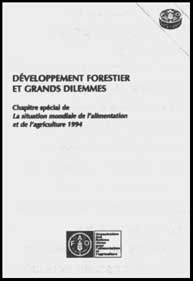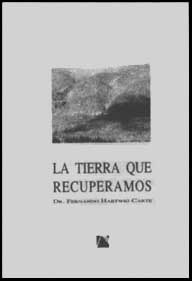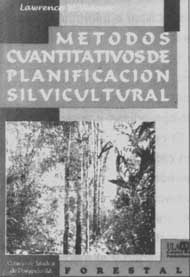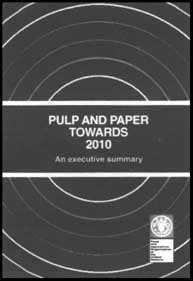The state of food and agriculture
Forest management in Chile
Quantifying silvicultural planning
A practical guide for the introduction of ecology in rural primary education
Trends in the consumption, production and trade of pulp and paper products
Special chapter on Forest development and policy dilemmas
The State of Food and Agriculture, FAO's annual report on recent developments affecting world agriculture, presents facts and figures on the global agricultural situation and a review of the economic environment surrounding agriculture as well as specific topics of particular relevance. Each year, a special chapter covers a selected aspect in greater depth; in the 1994 issue, it was entitled Forest development and policy dilemmas.

The purpose of the special chapter is to enhance the understanding of how economic and social policies affect forest resources. While it does not attempt to lay out an agenda for action or establish a set of correct policy choices, the chapter aims to raise awareness and inform a full range of professional and public interests so that forest issues can be better understood and appreciated.
The chapter is organized in five sections. The first reviews the current state of forest resources and their importance to economies, societies and the environment. Section II provides an overview of the changing role of forestry in development strategies and national economies. It describes how forests have evolved out of a narrow sectoral prerogative to enter mainstream political interests involving highly diverse groups.
Section III discusses key issues facing policy-makers and examines how economic policies affect forest resources. It reviews the literature, examining macro, intersectoral and forestry sector policy implications. This section also introduces the concept of landscape formation models as an example of how to recognize, explain and direct policy interactions that influence how people use forests.
Section IV explores the relationship between forest trade policies, forest management practices and their environmental impacts. The costs and administrative implications of certification schemes for forest products are also reviewed and compared.
The final section examines future directions for forestry policies in contributing to sustainable development. It suggests that a major task for governments is to develop national frameworks to deal explicitly with the consequences of their overall policy choices on forests and to establish priorities between forests and other national interests.
For many of the readers of Unasylva, the information presented in The State of Food and Agriculture's special chapter on forestry will be familiar. However, the wide-ranging and succinctly presented text will be of value in putting various concepts into perspective and will also be a particularly useful reference tool when presenting the complex issues facing forestry today to non-specialists.
La tierra que recuperamos. F. Hartwiq Carte. 1994. Santiago, Chile, Editorial Los Angeles.

With this sequel to Chile, desarrollo forestal sustentable - Ensayo de política forestal (Editorial Los Andes, 1991), Dr Hartwig Carte once again draws on his expertise and extensive national and international experience to portray forestry development in Chile in a highly interesting policy perspective.
The title and first few pages tell us that the author wishes to address the problems and prospects of forestry development in the context of conservation of what he sees as an irreplaceable resource of paramount importance to the environment: soil.
He begins by listing a number of historical events that have marked agricultural and forestry development in the country, before outlining the influential role played by a number of national and foreign scientific luminaries. He then recounts the introduction of species that now constitute the backbone of forestry development in the country and examines the sectoral impact of government agrarian and economic policy over the years.
Briefly analysing land-use patterns in the various forest regions of the country, the author looks into some of the problems that condition reforestation policy, such as size and structure of property, land-use capacity and international competition.
He emphasizes the need to step up the reforestation of degraded and formerly agricultural land, not only to obtain forest raw material but particularly - to protect the soil (a natural resource that, once lost, is to all practical purposes irretrievable), to foster microclimates and water availability and to act as a carbon dioxide sink. He endorses reforestation with exotics that, once acclimatized to local conditions (e.g. Pinus radiata), produce high yields.
Hartwig Carte advocates maintaining the present rate of planting and calls for stable forestry legislation, clearly defined rules of economic interplay and, where needed, continued research with the objective of supporting forestry activity and instilling and fostering public awareness.
The author proposes a modern approach to forestry and analyses in some detail the regional climate, soil, altitude and latitude differences as well as how these influence forest production. He compares plantations of similar species in various countries to determine Chile's international competitiveness and stresses the need for continued research to safeguard the country's competitive edge and keep forest management and production costs low.
The author squarely addresses the contentious issue dividing ecologists and foresters: should exotic species that are seemingly appropriate in terms of the ecology and geography of their country of origin be planted in degraded natural forests?
Finally, the book looks at the forest industrialization and commercialization process that gave impetus to forest plantations, thereby generating national and regional, social and economic development. It also briefly examines the international timber trade and Chile's market potentialities.
The author sums up by proposing a series of technical, policy and administrative proposals designed to clarify and resolve the Chilean forestry sector's problems and thus to amplify its prospects and contribution to national social and economic development.
Although many of Hartwig Carte's perspectives are provocative and will not necessarily be shared by all readers, this book is unquestionably a valuable contribution to the present debate on forestry development, not only in Chile but in the world at large.
M. Paveri
Métodos cuantitativos de planificación silvicultural - selección del sistema silvicultural pare el manejo del bosque tropical alto. L.W. Vincent. 1993. Mérida, Venezuela, Consejo de Publicaciones, Universidad de Los Andes. ISBN: 960-221-546-5.
This publication caters particularly to postgraduate students specializing in tropical forest management and to foresters working in the same area, especially those involved in formulating and revising management plans.
The author gradually pieces together a quantitative methodology for forestry planning by introducing theoretical principles and notions and the tools to optimize the planning component of tropical forest management.
The reader is given a hands-on role in formulating the methodology. The step-by-step process starts by defining the problem of forest management and then considers some of the basic aspects of management science and operations research as they relate to decision-making and optimization of results.
The book goes on to introduce the basic tools for inventorying the various silvicultural options (alternative systems or methods), grouping these options into categories, appraising the status and trends of tropical forestry and, finally, determining the successive stages inherent in the forestry plan.
A second volume, nearing completion, will develop specific quantitative tools, particularly those needed to acquire decision-support data (regeneration samples, etc.) and to devise analytical ways of determining whether there is adequate forest regeneration at any given time.
S.A. Dembner
Ecologia y enseñanza rural: manual pare profesores rurales del area andina. FAO Forestry Paper No. 121. 1994. Rome, FAO. U5$14.00. ISBN: 92 -5-303522-6.

Rural schools are expected to encourage, guide and develop the intellectual, moral and technical capabilities of rural children. They thus have an important role to play in development. One of their key tasks is preparing children to face, understand and resolve the difficult problems they will be up against as they subsequently try to better their living conditions, whether it be in their home communities or in the urban areas to which they have migrated.
School curricula and teaching methodologies need to address the bond between local society and environment and the education programme should include activities that will engender respect for nature and generate awareness of the need for human and natural resource symbiosis.
If rural education is to have a stronger impact on development and particularly on sustainable resource management, then efforts must be made to identify the many instances of successful environmental education so that these can be technically refined, given proper form and widely disseminated.
Such is the purpose of this handbook, which is a useful and practical working tool for the rural teacher. Ecología y enseñanza rural sets out to give primary education an ecological dimension adapted to the needs and interests of rural children and based on didactic materials at hand. The guiding concept is that education should be activity-oriented and participatory.
The handbook analyses basic curriculum structure, the introduction of ecology in education and teaching methodology in rural situations. It also suggests projects and activities involving reflection, action, experimentation and the development of sensitivity, intelligence, ethical values and manual skills.
Ecología y enseñanza rural is aimed at the rural teacher who has limited economic resources but ample enthusiasm and creativity as well as a keen sense of responsibility.
S.A. Dembner
Pulp and paper towards 2010: an executive summary. 1994. Rome, FAO. ISBN: 92-5-103540-7.

Pulp and paper towards 2010 presents the main findings of an assessment carried out by the statistics and economic analysis staff of the FAO Forestry Department, covering the prospects for pulp and paper and their contribution within the forest and forest industry sector to meeting the basic needs of society and securing sustainable development, conservation of natural resources and the environment and an equitable distribution of social wellbeing.
Pulp end paper towards 2010 provides key data and projections to 2010 on paper and paperboard consumption, fibre consumption and the implications for recycling recovered paper and the demand for wood for pulp and paper manufacture in all regions and countries. Sections cover: paper in the economy; paper consumption; communications and packaging; paper production; fibre raw material; the outlook for pulp and paper; pulp and paper trade; paper and the environment; and perspective towards 2010 and beyond. In addition, the publication includes a commentary by the FAO Advisory Committee on Pulp and Paper. The clearly written text is supported by numerous tables, graphs and maps indicating trends and geographic distribution
Pulp and paper towards 2010 is based on FAO production and trade statistics, published in the FAO Yearbook of Forest Products since FAO's foundation in 1945, and FAO pulp and paper capacities data collected from industry Econometric projections of the relationship between consumption, production and trade in forest products use UN and World Bank forecasts of economic development.
Pulp and paper has a vital contribution to make to sustainable development. The realization of this potential requires a well-informed pulp and paper industry with a commitment to wise management and the investments necessary to conserve and develop forest resources and technologically efficient as well as environmentally sound practices. Pulp and paper towards 2010 makes an important contribution to increasing awareness of what needs to be done to improve the pulp and paper sector's response to society's demand for these products and to move towards an optimum combination of profitability and environmental conservation